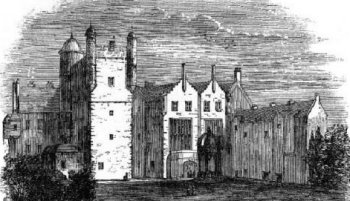Annotation:Lady Hope of Pinkie
X:1 T:Lady Hope of Pinkie M:C L:1/16 R:Strathspey Q:"Slowly" C:Nathaniel Gow (1763-1831) B:Gow - Sixth Collection of Strathspey Reels (1822) Z:AK/Fiddler's Companion K:Bb d2|BB3 b4 a2f2 g4|f3de3c d2B2 A2F2|BB3 b4 a2f2 f3g|f3de3c TB4 B,2d2| BB3 b4 a2f2 g4|f3de3c d2B2 A2F2|BB3 b4 a2f2 ~f3g|f3de3c TB4 B,2||F2| (DEF2) B2D2 E2G2 B4|(ABc2) (.c2.c2) d2e2 f4|(DEF2) B2D2 E2G2 c3B|(ABc2) F3A TB4 B3F| (DEF2) B3D E2G2 B2B2|(ABc2) (edc2) ~d3e f4|(3D2B2f2 (3f2D2f2 (3g2E2g2|(3F2c2a2 .a2.F2.a2 b4 B2||
LADY HOPE OF PINKIE. Scottish, Strathspey. B Flat Major. Standard tuning (fiddle). AB. Composed by Nathaniel Gow (1763-1807). Pinkie House is located in Musselburgh, East Lothian, Scotland. It is a mansion built around a three-story tower, and has been renovated and added to several times since the 16th century.

Lady Hope at the time of the Gow's Sixth Collection (1822) was Anne (1788-1867), 4th and youngest daughter of Sir John Wedderburn of Blackness and Ballindean, Bart., who married Sir John Hope (1781-1858) of Craighall co. Fife, and Pinkie, 11th Bart., in 1805. He was an MP for Edinburgh for eight years and an excellent horseman (his father, Alexander, had been head of the Caledonian Hunt). The couple had two daughters and eight sons. The Hope family came late to Pinkie House, acquiring it from the Hay family in 1778. See also William Shepherd's "Annotation:Miss Hope of Pinkie House’s Strathspey" for more notes.
